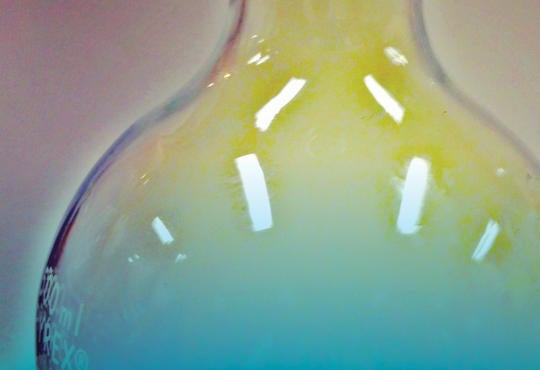Kacey and I wrote an article about the many versions of “Slime” or “Gak” or whatever you would like to call it in Chem 13 News, October 2016. At that time, Jean Hein, editor, showed us a Canadian advisory update which expressed the potential health hazards of using borax. We offered starch as a replacement for borax in April 2017. Recently, in the “Letters to the Editor,” September 2017, it was pointed out that commercial sources of
starch may contain borax. We investigated these hazards; the following are our results.
Sta-Flo® starch does contain some borax according to the label, so it is not a valid replacement. Contact lens cleaner was also suggested as a valid cross-linker (Office Depot®); however, it too contains a small amount of borax (<1%).
We also make a starch solution with Niagara® brand aerosol spray starch. We make it ahead of time, not involving the audience, because the propellant used is flammable. When the exact concentration of the starch solution does not need to be known using the aerosol spray is a quick way to make it. Heat water to near boiling using a hot plate (do not use an open flame and remember while newer hot plates are manufactured to avoid sparks, older hot plates may have a spark risk.) Spray small amounts of starch directly into the water with stirring. Repeat the process until the mixture becomes cloudy white. Allow mixture to cool to room temperature. The starch solution can be stored for several months. Mold does tend to form after a while. We suggest labelling the bottle with the date made, discarding after a few months or when mold is visible. I observed this method at a ChemEd conference — sorry, I do not remember which one. The Niagara® brand nonaerosol spray starch, at this time, does not label the ingredients, however, SDSs are available on line. According to the website, it contains water, modified corn starch, silicone, fragrance, preservative and an additive. Ethylene glycol is likely the additive — no borax. The non-aerosol version may be sprayed directly into the glue-water mixture to form the slime.
It was questioned whether starch alone could be used to form the slime. We made a solution of starch by using Fisher® brand (Duke has a contract with Fisher®) of soluble starch S25582. According to the SDS, it is 100% soluble starch. A solution was made by heating approximately 150 mL of water to near boiling and then slowly added about 1 g of the soluble starch. When the mixture was cloudy, we removed it from the heat, let it cool, covered it with clear plastic wrap and let it set overnight so the starch could completely absorb the water and be dispersed. We then added about 2 teaspoons of the starch solution to about 100 mL of the 50-50 glue-water mixture, with stirring. The slime formed rapidly and had all the same properties as the borax slime.
It was also suggested that guar gum could be used to form crosslinks with the polymers in the glue. Both guar gum and starch are used as thickening agents in cooking and commercially. Guar gum is a straight chain galactomannan with galactose on every other mannose unit. Starch also has a linear structure with glucose units instead of galactose. So why not? We made a guar gum solution, similar to the process used to make the starch solution, added it to the glue-water mixture, and slime
was formed! So in conclusion, there are methods that do not require
the use of borax to make slime and the materials are readily available to do so. We wish to thank Ed Escudero and David A. Katz for their input on this topic. And thanks to Jean Hein for allowing us to use Chem 13 News
as a platform to carry on this discussion.
Kenneth Lyle and Kacey Hall
Duke University, Durham, North Carolina
[We asked Ed and David if they would like to add to Kacey and Ken’s non-borax slime research before we put the subject to bed.]
» I would be wary of using an aerosol spray starch near a hot plate due to the possibility of a flammable propellant. (Hot plates may spark internally and not every teacher has a sealed laboratory type hot plate.) There is an easier way to make up a starch solution. It works for starch, polyvinyl alcohol, guar gum and other substances in preparing suspensions. I developed it when traveling and doing numerous presentations on a long trip. Mix the substance (starch, etc.) with room temperature water — usually in a beaker and stir well. Place the container in a standard microwave oven. Heat for about 30 seconds to one minute depending on the amount of liquid. Remove and stir. Return to the microwave and heat for 15 second intervals, stirring each time. Once a uniform colloidal suspension forms, it is done. For a liter of solution, total heating time is usually less than 5 minutes. The mixture will be hot. The boiling point of the water is never reached.
It should also be noted that no matter what the propellant is, care must be taken with any spray or atmosphere of fine particles. It can be flammable. Recall dust explosions.
David A. Katz, Chemist and Educator,
Tucson, Arizona
www.chymist.com
» I have broken large beakers trying to make solutions using a hot plate. I have never had any problems using the microwave method. I did not know David was the one who developed it.
Ed Escudero (retired)
Summit Country Day School
Cincinnati, Ohio







